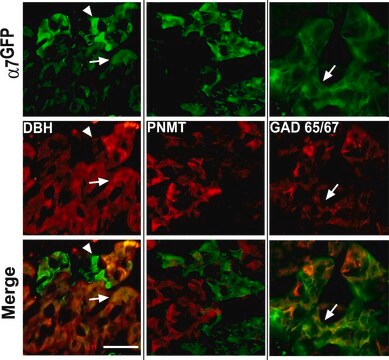AB733
Anti-Tamm-Horsfall Glycoprotein Antibody
serum, Chemicon®
About This Item
Produits recommandés
Source biologique
sheep
Forme d'anticorps
serum
Type de produit anticorps
primary antibodies
Clone
polyclonal
Espèces réactives
human
Fabricant/nom de marque
Chemicon®
Technique(s)
immunodiffusion: suitable
immunohistochemistry: suitable
western blot: suitable
Numéro d'accès NCBI
Numéro d'accès UniProt
Conditions d'expédition
wet ice
Modification post-traductionnelle de la cible
unmodified
Informations sur le gène
human ... UMOD(7369)
Spécificité
Immunogène
Application
RID and Rocket RID: 10 μL antiserum/cm2 in gel vs. 5 μL uromucoid (50 mg/L), NT - 1/5
Double diffusion: 10 μL antiserum vs. 3 μL uromucoid (50 mg/L)
*Note: The use of 3% PEG 6000 with 1.2% agarose in a suitable buffer (such as TBE or Tris-barbital pH >8.2) is recommended for the above applications.
Immunohistochemistry
Optimal working dilution must be determined by the end user.
Inflammation & Immunology
Immunoglobulins & Immunology
Forme physique
Stockage et stabilité
Informations légales
Clause de non-responsabilité
Vous ne trouvez pas le bon produit ?
Essayez notre Outil de sélection de produits.
Code de la classe de stockage
12 - Non Combustible Liquids
Classe de danger pour l'eau (WGK)
WGK 1
Point d'éclair (°F)
Not applicable
Point d'éclair (°C)
Not applicable
Certificats d'analyse (COA)
Recherchez un Certificats d'analyse (COA) en saisissant le numéro de lot du produit. Les numéros de lot figurent sur l'étiquette du produit après les mots "Lot" ou "Batch".
Déjà en possession de ce produit ?
Retrouvez la documentation relative aux produits que vous avez récemment achetés dans la Bibliothèque de documents.
Notre équipe de scientifiques dispose d'une expérience dans tous les secteurs de la recherche, notamment en sciences de la vie, science des matériaux, synthèse chimique, chromatographie, analyse et dans de nombreux autres domaines..
Contacter notre Service technique